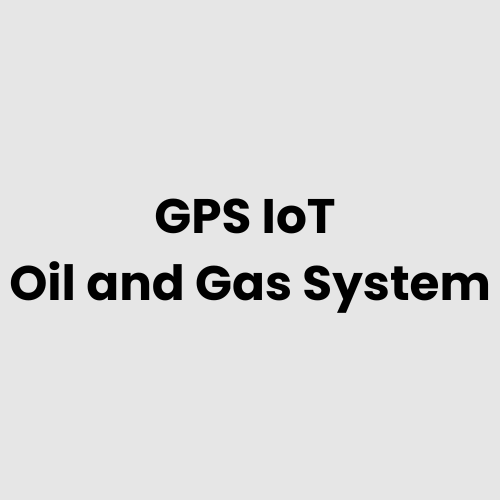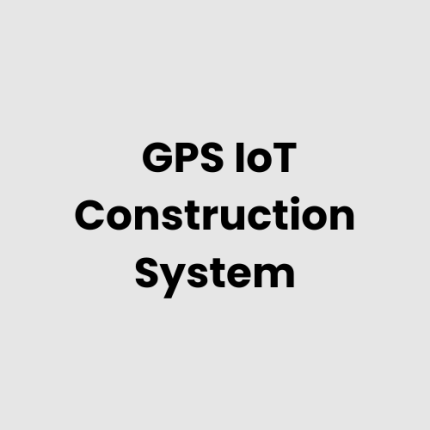Description
Technical Architecture of GPS IoT Enabled in Oil and Gas IoT System
The technical architecture of GPS IoT Enabled in Oil and Gas IoT System integrates a network of devices and systems that enable real-time tracking, monitoring, and management of assets within the oil and gas industry. The architecture typically consists of three main layers:
- Device Layer: Includes GPS tracking devices, sensors (temperature, pressure, flow, etc.), and IoT-enabled devices installed on various equipment like pumps, valves, and pipelines.
- Communication Layer: Facilitates data transmission from the field to centralized systems via secure communication protocols, such as cellular, satellite, or low-power wide-area networks (LPWAN).
- Cloud/Server Layer: Data is collected, processed, and analysed in real time using cloud-based platforms or local servers. This layer provides insights and reporting dashboards for operators and decision-makers.
GAO Tek’s GPS IoT-enabled solutions ensure secure, real-time data flow across these layers, helping customers monitor and optimize their operations.
Hardware of GPS IoT Enabled in Oil and Gas IoT System
The hardware for GPS IoT Enabled in Oil and Gas IoT System includes:
- GPS Trackers: Devices designed for asset location tracking, including both moving and stationary assets.
- Sensors: For monitoring environmental conditions, pressure, temperature, flow rate, and more.
- IoT Gateways: Bridge the communication between local devices and the central server or cloud.
- Remote Communication Modules: Such as LTE, satellite, or LPWAN modules to transmit data from remote locations.
- Edge Devices: Devices with local processing capabilities to perform real-time data analysis before transmitting information.
- Power Supplies: Including batteries and solar panels for devices located in remote or off-grid locations.
- Ruggedized Enclosures: For protecting devices in harsh and hazardous oil and gas environments.
GAO Tek supplies high-quality hardware optimized for rugged environments, ensuring reliability and performance in challenging oil and gas operations.
Physical Placement Considerations of the Hardware
When deploying GPS IoT Enabled in Oil and Gas IoT systems, several physical placement factors must be considered:
- Environmental Conditions: Devices must be placed in areas that can withstand harsh weather, high temperatures, or corrosive environments. This requires the use of rugged enclosures for protection.
- Power Availability: Ensure that devices are placed near power sources or incorporate battery/solar options for remote installations.
- Accessibility: Devices should be placed in locations that are easily accessible for maintenance, yet protected from tampering or damage.
- Signal Strength: GPS devices and sensors need to be placed where they have clear line-of-sight to satellites for accurate location tracking and reliable data transmission.
- Safety: Comply with oil and gas industry safety standards by placing devices in explosion-proof enclosures in hazardous zones.
GAO Tek works with customers to ensure optimal placement of hardware, maximizing efficiency and minimizing downtime in critical environments.
Hardware Architecture of GPS IoT Enabled in Oil and Gas IoT System
The hardware architecture consists of interconnected components that work together to collect, transmit, and process data:
- Field Devices (Sensors & GPS Trackers): These collect real-time data from equipment and assets, such as flow meters, pressure sensors, and temperature gauges.
- Local IoT Gateways: These devices aggregate data from sensors and trackers, handling data filtering and transmission to the central server or cloud.
- Communication Infrastructure: Utilizes satellite, LTE, or LPWAN networks to transmit data from remote oil rigs or pipelines to the central system.
- Cloud or Local Servers: Store and process data for real-time monitoring and long-term analytics. These systems generate actionable insights for operators.
GAO Tek’s hardware solutions integrate seamlessly into existing operations, ensuring the efficient collection and transmission of data across these architecture layers.
Deployment Considerations of GPS IoT Enabled in Oil and Gas IoT System
When deploying GPS IoT Enabled in Oil and Gas IoT systems, the following considerations must be addressed:
- Remote Location Accessibility: Oil and gas operations often take place in remote, hard-to-reach areas. Reliable communication networks, including satellite and cellular coverage, must be available for consistent data transmission.
- Data Security: Implement strong encryption protocols to ensure data confidentiality and integrity, especially when sensitive operational data is transmitted.
- Scalability: Ensure that the solution is scalable to accommodate future expansions, with the ability to add more sensors or devices as needed.
- Integration with Existing Systems: The IoT system must be compatible with legacy equipment and IT systems in the oil and gas environment to ensure smooth integration and minimal disruptions.
- Compliance with Industry Standards: Adhere to oil and gas industry standards, such as explosion-proof certifications and environmental regulations, to guarantee safety and operational integrity.
GAO Tek assists in streamlining the deployment of GPS IoT systems, offering expert guidance and support at every stage, from initial design to full-scale implementation.
List of Relevant Industry Standards and Regulations
- ISO 9001:2015 – Quality Management Systems
- ISO/IEC 27001:2013 – Information Security Management
- ATEX Directive (2014/34/EU) – Equipment for explosive atmospheres
- IECEx – International Certification Scheme for Explosive Atmosphere Equipment
- API RP 500 – Recommended Practice for Classification of Locations for Electrical Installations in Petroleum and Chemical Plants
- FCC Part 15 – Radio Frequency Devices (for communication modules)
- IEEE 802.15.4 – Wireless Personal Area Networks (used in LPWAN technologies)
- OSHA Regulations – Occupational Safety and Health Administration for workplace safety
Local Server Version (Running with a Local Server)
A local server version of the GPS IoT Enabled in Oil and Gas IoT system can be implemented for environments where cloud connectivity is limited or where data privacy concerns dictate local processing. In this version, all data is captured, processed, and stored on-site, ensuring that operations continue smoothly without relying on external internet connections.
GAO Tek’s solutions offer flexible deployment options, allowing customers to choose between cloud-based or local server setups, depending on their specific operational needs.
Cloud Integration and Data Management
For GPS IoT Enabled in Oil and Gas IoT, cloud integration provides enhanced capabilities for real-time monitoring, advanced analytics, and long-term data storage. Data from the field is transmitted to the cloud, where it can be accessed by operators and managers from anywhere, on any device.
- Data Transmission: Data from GPS trackers and sensors is sent to the cloud using secure communication protocols.
- Data Processing: Once in the cloud, data is processed in real-time using advanced algorithms to detect anomalies or inefficiencies, sending alerts to operators if necessary.
- Data Storage: Historical data is securely stored in the cloud, enabling long-term analysis and the ability to generate reports or review trends.
- Analytics and Insights: Cloud platforms provide powerful tools for predictive maintenance, operational optimization, and resource allocation by analysing large volumes of data from multiple sources.
GAO Tek’s cloud-integrated IoT solutions empower businesses to optimize their oil and gas operations, providing enhanced decision-making capabilities and real-time insights that drive efficiency and reduce costs.
GAO Case Studies of GPS IoT Enabled in Oil and Gas IoT System
USA Case Studies
- Houston, Texas
In Houston, the integration of GPS IoT technology was implemented to track and monitor the movement of drilling equipment. Real-time data from GPS sensors was collected, enabling operators to ensure the equipment’s optimal positioning and prevent operational delays. The solution also helped reduce the risk of equipment theft in high-value oilfield machinery. - Dallas, Texas
A large oil and gas operator in Dallas employed GPS IoT solutions to monitor pipeline pressure and flow across several remote locations. The system provided real-time alerts for any anomalies, helping maintenance teams address issues promptly and reducing the risk of costly leaks and environmental damage. - Denver, Colorado
GPS-enabled IoT devices were deployed to monitor the performance of wellheads and pumps in Denver. Data from pressure sensors and GPS trackers were sent to a centralized system, allowing operators to remotely monitor performance and schedule predictive maintenance, thus improving operational efficiency and minimizing downtime. - Los Angeles, California
In Los Angeles, a GPS IoT solution was implemented for tracking the logistics of fuel transportation trucks. The system allowed for real-time location tracking and fuel consumption monitoring, optimizing fuel deliveries and minimizing delays while ensuring compliance with environmental and safety regulations. - New Orleans, Louisiana
A major offshore oil platform in New Orleans integrated GPS IoT technology to track its mobile drilling rigs and other assets. The system provided location data and performance metrics, enhancing safety and asset management, while also offering predictive analytics for proactive maintenance and operational planning. - Oklahoma City, Oklahoma
In Oklahoma City, GPS IoT systems were used to monitor the integrity of oil pipelines running through both urban and rural areas. Sensors placed at key junctions allowed for real-time monitoring of pipeline conditions, including pressure levels and potential leakages, helping mitigate risks and avoid operational disruptions. - Bakersfield, California
A Bakersfield-based oil company utilized GPS IoT technology to optimize the scheduling and routing of service trucks. By tracking vehicle location and fuel usage, the company was able to streamline operations, reduce fuel costs, and enhance the overall logistics efficiency across its oilfield service fleet. - Anchorage, Alaska
In the challenging environment of Alaska, a GPS IoT solution was implemented to monitor the safety and performance of drilling equipment. Remote sensors sent real-time data regarding equipment health, while GPS trackers provided exact locations of machinery, ensuring safety and minimizing risk during harsh weather conditions. - Jacksonville, Florida
In Jacksonville, GPS IoT technology was used to monitor a series of underwater pipelines. Data from GPS and environmental sensors were relayed in real time to a cloud-based system, providing operators with up-to-the-minute information on pipeline health and immediate alerts in the case of any irregularities, reducing environmental risk. - Louis, Missouri
A major oil refinery in St. Louis deployed GPS IoT sensors to monitor the real-time status of critical equipment and supply lines. With IoT sensors collecting data on temperatures, pressures, and locations, the system allowed for proactive maintenance scheduling, reducing the chances of unplanned shutdowns. - Tulsa, Oklahoma
In Tulsa, a large-scale oil drilling operation integrated GPS-enabled sensors to track equipment in real-time across its extensive site. This system improved asset utilization, reduced downtime, and allowed for the better allocation of resources, ensuring that equipment was always where it was needed the most. - Richmond, Virginia
A GPS IoT-based solution was used by a Richmond-based oil distributor to manage fleet logistics. The system tracked vehicle routes, fuel consumption, and engine performance, leading to better route optimization, reduced fuel expenses, and enhanced fleet safety by monitoring driver behaviour. - Detroit, Michigan
In Detroit, GPS IoT technology was adopted to monitor the movement of oil tankers and ensure timely deliveries. The system provided real-time GPS location data and predictive maintenance alerts for tankers, optimizing fleet management and reducing delays caused by mechanical failures. - Chicago, Illinois
A GPS IoT system was employed by an oil and gas company in Chicago to monitor the integrity of its storage tanks. IoT sensors collected real-time data on the tanks’ internal conditions, while GPS trackers allowed operators to locate and inspect equipment efficiently, improving operational safety and reducing operational costs. - Phoenix, Arizona
Phoenix-based oil operations leveraged GPS IoT to monitor the condition of wellheads in remote desert areas. By collecting data from various sensors (temperature, pressure, and flow), and transmitting it to a centralized server, operators were able to perform predictive maintenance, avoiding costly wellhead failures.
Canada Case Studies
- Calgary, Alberta
In Calgary, a major oil company implemented GPS IoT solutions for monitoring pipeline conditions across rugged and remote terrain. Real-time location tracking and pressure sensor data helped detect issues early, minimizing the risk of pipeline failures and reducing operational costs in challenging environments. - Vancouver, British Columbia
Vancouver-based oil and gas operations utilized GPS IoT devices to track the performance and health of offshore drilling platforms. Sensors collected environmental data and provided location tracking, allowing for remote monitoring and early detection of potential equipment malfunctions, enhancing safety and operational efficiency.
Navigation Menu for GPS IoT
- GPS IoT Trackers/Devices
- GPS IoT Tracking Accessories
- GPS IoT Tracking Resources
- GPS IoT – Cloud, Server, PC & Mobile Systems
Navigation Menu for IoT
- LORAWAN
- Wi-Fi HaLow
- Z-WAVE
- BLE & RFID
- NB-IOT
- CELLULAR IOT
- GPS IOT
- IOT SENSORS
- EDGE COMPUTING
- IOT SYSTEMS
Our products are in stock and can be shipped anywhere in the continental U.S. or Canada from our local warehouse. For any further information, please fill out this form or email us.
We are actively looking for partners who are like us located in the U.S. and Canada. For more information on partnering with GAO, please visit Partner with GAO Tek Inc. It lists various ways to partner with GAO, such as OEM Partnerships, Technology Integration, Distribution and Reselling Opportunities, Presenting at the Leading Event Tek Summit, Joint R&D Projects, Training and Consulting Services, Industry-Specific Collaborations, Research and Academic Partnerships.



